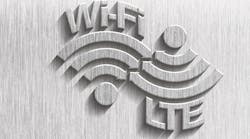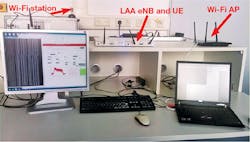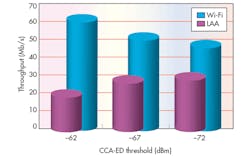LAA: LTE and Wi-Fi Coexistence or Convergence?
This file type includes high-resolution graphics and schematics when applicable.
Using cellular and Wi-Fi together in a mobile device has now become an expectation. Not only should they work together, but they should be enabled to work together seamlessly at the switch of a button. LTE and Wi-Fi have coexisted and been complementary for years, but researchers have recently proposed new LTE and Wi-Fi coexistence technologies to enhance the user’s mobile data experience. As demand for mobile data access continues to escalate, these technologies will likely be commercialized and deployed in the near future.
LTE and Wi-Fi coexistence technologies share a common premise—using an LTE air interface in the 5-GHz unlicensed band. Cellular service providers have exclusive rights to operate networks in spectrum they purchased (in some cases for billions of dollars/euros). Wi-Fi is deployed in the 2.4- or 5-GHz (U-NII-1 and U-NII-3)1 unlicensed bands available to anyone and everyone as long as users follow the laws that govern the spectrum.
While sharing the spectrum is an opportunity, it also presents many challenges. Thus, multiple proposals are being considered for standardization.
What Does It Mean to “Coexist”?
Two LTE/Wi-Fi coexistence technologies of note include LTE-Unlicensed (LTE-U) and Licensed Authorized Access (LAA). The LTE-U standard is driven by Alcatel-Lucent, Ericsson, LG Electronics, and Qualcomm Technologies Inc., who comprise the membership of the LTE-U Forum2—an organization committed to the adoption and proliferation of the LTE-U standard. LAA is a variation of LTE-U going through 3rd Generation Partnership Program (3GPP) standardization for inclusion in 3GPP Release 13 (March 2016).
Both LTE-U and LAA likely will be commercialized and deployed. At issue is the question of “coexistence”: What does it mean to share spectrum fairly? Both LTE-U and LAA have mechanisms in place to enable sharing with Wi-Fi devices, but the actual impact will likely not be fully understood until more testing is conducted and after the first deployments.
Data Sharing—Another Dimension
Cellular and Wi-Fi have coexisted for over a decade, with each standard and implementation fulfilling a unique set of needs. Simply, cellular (LTE) provides mobility and Wi-Fi addresses localized high data-rate access. In fact, cellular devices utilizing Wi-Fi offloading shouldered 55% of all mobile traffic in 2015.3
So, how is LTE-U/LAA different from cellular/Wi-Fi offloading? For the cellular data user, the impact is tangible. In geographic regions where Wi-Fi is not present, service operators can offer LTE over 5-GHz bands to double or triple the mobile data user experience. In your own home or a brick-and-mortar office building, the benefits of LTE-U/LAA are less clear. In both of these cases, the Wi-Fi access point will be known and Wi-Fi offloading can occur seamlessly.
LTE-U
LTE-U utilizes the LTE-Advanced carrier aggregation (CA) framework adopted in 3GPP Release 10, where the data streams are independent and aggregated outside the communication protocol stack. As in CA, LTE-U extends the concept of a primary or anchor cell, and one or more “data” or “secondary serving cells” (SSCs). LTE-U proposes the unlicensed band be added as a SSC used for downlink while the primary cell connection would be reserved for control and uplink.
Sharing in the unlicensed band is achieved through a carrier sense adaptive transmission (CSAT)4 approach. In CSAT, the Wi-Fi band is monitored over time to assess traffic patterns. This allows dynamic channel selection and adaption of the transmit duty cycle to minimize impact to incumbent devices operating in the 5-GHz band (Fig. 1). Early rollout of LTE-U, as it is defined today, will be limited to countries that permit CSAT in unlicensed bands.
LAA (Downlink Only)
As part of 3GPP Release 13,5 LAA adopts the LTE-U CA approach. However, the channel access approach is much closer to the Wi-Fi implementation that uses a listen-before-talk (LBT) method, which is called carrier sense multiple access with collision avoidance (CSMA/CA).
LBT ensures global compliance and should facilitate a global roll-out without changes in the regulation for unlicensed bands. Various options were considered for detection, with the result being a Wi-Fi-like system with an initial defer period and exponential back-off. An example waveform is shown (Fig. 2), in which the LBT procedure is used based on energy detection to sense the channel and determine transmit opportunities (TXOP) for as many as 10 LTE subframes.
It should be noted that LTE-U and LAA include uplink and downlink. However, 3GPP Release 13 only includes LAA downlink, while uplink is scheduled to be considered for Release 14.
Is “Fair” Coexistence Realistic?
Assigning a common definition to the term “fair” has presented challenges. Experimental results so far have typically been directly aligned to the business interests of the publishing research group. Chip and infrastructure vendors have produced results supporting LTE-U, while Wi-Fi and cable providers generally found the technology to be problematic or inconclusive at best.
The two most debated challenges with coexistence include:
• The ability for legacy devices in the unlicensed bands to detect a free channel.
• The ability for LAA implementations to detect and avoid conflicts with the right level of aggressiveness (often tuned through energy level threshold and backoff).
The proponents of LTE-U have shown results indicating the deployment of these networks do not significantly degrade Wi-Fi network performance.6 However, papers like that in ref. 7 disagree, since LTE-U does not implement LBT mechanisms (such as CSMA/CA with defer period and exponential back-off as in Wi-Fi), as they believe it is critical to fair sharing of unlicensed channels.
Some regulatory regimes, such as those in Europe and Japan, require LBT in unlicensed bands. Therefore, LTE-U cannot be deployed in those regions. Due to the controversial nature of LTE-U, regulators like the FCC in the U.S., where LTE-U can be deployed without LBT, are reviewing input from the ecosystem and evaluating if further regulation is needed.8
Wi-Fi providers have indicated a preference for LAA over LTE-U, because they can participate in the open standards process. In addition, they expect LBT design to be critical to achieve good coexistence performance.
Testing Scenarios
As with any new technology, prototyping using a realistic testbed is the best way to truly understand the performance tradeoffs. Given the complexity and closed nature of Wi-Fi and LTE chipsets, most trials and research up to this point have been conducted by the vendors of the devices themselves.
National Instruments (NI) has also introduced a neutral, modifiable prototyping platform (Fig. 3) that is based on software-defined radio (SDR). This platform enables researchers to evaluate and compare performance tradeoffs of such algorithms in realistic environments.9 The real-time LTE physical layer (PHY) and real-time Wi-Fi PHY can be modified in the LabVIEW Communications System Design environment to evaluate over-the-air performance of both LAA and LTE-U scenarios.
LAA experimentation requires adaptation of the standard LTE protocol for several reasons:
• Operation at a new center frequency (typically the 5-GHz Wi-Fi band).
• Enhanced PHY to incorporate discontinuous transmission (DTX).
• Enhanced PHY to incorporate listen before talk (LBT, Category 4).
In the case of LTE-U, LBT is replaced by duty cycling and puncturing imposed on the LTE frame structure at the resolution of LTE subframes. Discontinuous transmission can be done to include support for LTE-U patterns.
Testing Results
The NI LTE/Wi-Fi Coexistence Testbed with LAA adaptations to the LTE PHY was used in conjunction with an off-the-shelf Wi-Fi access point. Throughput of a Wi-Fi 802.11ac waveform running in “Very High Throughput—40 MHz bandwidth mode (VHT40)” and LAA LBT Cat 4 system was analyzed with varying carrier-sensing energy-detection threshold values. Both the Wi-Fi 802.11ac access point and the LAA node observe one another with a received signal strength indicator (RSSI) of around –67 dBm (Fig. 4). More experiments and results can be found in 3GPP contributions.10,11
Conclusion
It was largely believed that 4G would make Wi-Fi offloading obsolete. However, it has only increased due to higher-consumption devices and cell-phone plan data-usage fees.1 The pivot toward LTE/Wi-Fi coexistence seems imminent, given the influence that infrastructure providers and chip vendors have in the industry. While LTE on unlicensed bands may help improve service in some scenarios, future proposals may further push LTE into unlicensed bands directly competing with Wi-Fi in other cases.
With all of these technologies, the details of the implementation will greatly impact the gains experienced in practice. As with most new wireless technologies, rapid prototyping and field trials are needed to evaluate usage scenarios and maximize the user experience for both the LTE user and the incumbents.
While the field trials conducted so far have not disqualified the concept, they have not created overwhelming evidence to favor any approach. More neutral research is needed to explore how incumbent Wi-Fi devices are affected, and how this impacts other devices and scenarios in heterogeneous networks that continue to increase in density and complexity.
The first large-scale demonstrations of 5G are being aligned to the 2018 and 2020 Olympic Games. Hopefully, though, we will not have to wait that long to benefit from the enhancements brought by 3GPP Release 13, often labeled 4.5G, to be rolled out into base stations and our smart devices.
James Kimery is Director of Product Marketing for RF Communications and Software-Defined Radio (SDR) at National Instruments.
Erik Luther is Senior Group Manager for Software-Defined Radio (SDR) at National Instruments.
Dr. Achim Nahler is Principal Software Engineer at National Instruments.
References:
1. 3GPP, "RP-151114: LTE-WLAN Radio Level Integration and Interworking Enhancement," 2015.
2. LTE-U Forum, [Online]. Available: http://www.lteuforum.org
3. CISCO VNI 2016, Available: http://www.cisco.com/c/en/us/solutions/collateral/service-provider/visual-networking-index-vni/mobile-white-paper-c11-520862.html
4. Qualcomm Technologies, Inc., "LTE-U Technology and Coexistence," LTE-U Forum Workshop, 28 May 2015. [Online]. Available: http://www.lteuforum.org/workshop.html
5. 3GPP, "RP-151045: New Work Item on Licensed-Assisted Access to Unlicensed Spectrum," 2015.
6. Qualcomm, "On LTE-U/Wi-Fi Coexistence," Wi-Fi LTE-U Coexistence Test Workshop, November 2015. [Online]. Available: http://www.wi-fi.org/file/wi-fi-lte-u-coexistence-test-workshop-presentations-november-2015
7. N. Jindal, D. Breslin, and A. Norman, "LTE-U and Wi-Fi: A Coexistence Study by Google," Wi-Fi LTE-U Coexistence Test Workshop, November 2015. [Online]. Available: http://www.wi-fi.org/file/wi-fi-lte-u-coexistence-test-workshop-presentations-november-2015
8. 3GPP, "RP-151045: New Work Item on Licensed-Assisted Access to Unlicensed Spectrum," 2015.
9. Real-time LTE/Wi-Fi Coexistence Testbed, Feb 16, 2016; http://www.ni.com/white-paper/53044/en/
10. "3GPP RAN1#82: Experimental Results on Coexistence of DL LAA and Commodity Wi-Fi Network with Cat 2 LBT," National Instruments, August 2015. [Online]. Available: http://www.3gpp.org/ftp/tsg_ran/WG1_RL1/TSGR1_82/Docs/R1-154740.zip
11. "3GPP RAN1#83: Experimental Results on Impact of Energy Detection Threshold for DL LAA," National Instruments, November 2015. [Online]. Available: http://www.3gpp.org/ftp/tsg_ran/WG1_RL1/TSGR1_83/Docs/R1-156622.zip
Looking for parts? Go to SourceESB.





